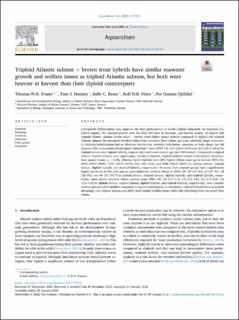| dc.description.abstract | Interspecific hybridisation may improve the farm performance of sterile triploid salmonids via heterosis (i.e. hybrid vigour). We assessed growth over the final 293 days in seawater, and harvest quality, in diploid and triploid Atlantic salmon (Salmo salar) × brown trout (Salmo trutta) hybrids compared to diploid and triploid Atlantic salmon. We measured vertebral deformities, cataracts, flesh colour, gut mass, and body shape at harvest. In triploids, hybridisation had no effect on harvest size, vertebral deformities, cataracts, or body shape, but did improve fillet colouration (Mean digital SalmoFan™ score [95% CI]: 24.6 [24.4–24.9] and 26.0 [25.7–26.2] for triploid salmon and triploid hybrids, respectively) and lower relative gut size (34% lower). Compared to diploid salmon, triploid salmon were significantly heavier at harvest, triploid hybrids tended to be heavier (Post-hoc, least square means, p = 0.08), whereas diploid hybrids were 83% lighter (Mean mass [g] at harvest [95% CI]: 2676 [2470–2898], 3395 [3134–3679], 462 [401–534], and 3086 [2832–3363] for diploid salmon, triploid salmon, diploid hybrids, and triploid hybrids, respectively). However, both triploid groups had a significantly higher incidence of fish with one or more deformed vertebra (Mean % [95% CI]: 23 [14–35], 60 [47–71], 38 [20–60], and 44 [31–57] % in diploid salmon, triploid salmon, diploid hybrids, and triploid hybrids, respectively), more severe cataracts (Mean cataract score [95% CI]: 3.0 [2.7–3.3], 3.5 [3.2–3.8], 2.2 [1.7–2.6], 3.6 [3.3–4.0] for diploid salmon, triploid salmon, diploid hybrids, and triploid hybrids, respectively), and a smaller relative gut size (21% smaller) compared to diploid counterparts. In conclusion, triploid hybrids have no growth advantage over triploid salmon and suffer from similar welfare issues while only benefiting from increased fillet colour. | en_US |
